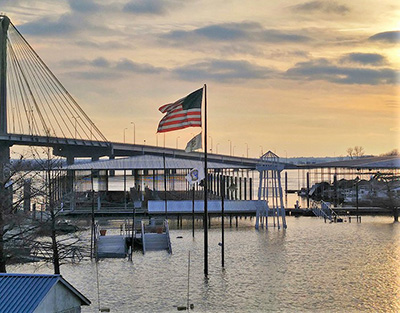Shoreline Resiliency - Design to Counter Climate Extremes
 Written by Bruce Lunde, MSA Professional Services
Written by Bruce Lunde, MSA Professional Services
![]()
Developing programs for shoreline stability and resiliency has been a significant topic recently. The Great Lakes have broken high water records over the last few years. In June, July, and August of 2019, Lake Superior broke all-time records for high water. Later that year, devastating storms rolled through causing significant damage to waterfront structures throughout Western Lake Superior. Duluth, Minnesota, has had significant damage to its lakewalk and is in the process of redesign and rebuild; a launch ramp at the mouth of the Brule River at Lake Superior has been completely destroyed; Bayfield, Wisconsin’s timber crib breakwall is in great need of rebuild and reinforcement. All this damage is causing engineers to rethink the approach to shoreline protection and resilient design—whether on these large bodies of water, or on inland rivers and streams.
To protect our shorelines, we need to re-evaluate our approaches to determining protection needs.
In the past, we used basic techniques to develop design basis models. We examined wind force, direction, and seasonal patterns and clear distances (fetch) to determine wave sizes. We also figured in seasonal ranges to be added to the wave heights. Finally, we added in set up, the occasional surges that are caused by seiche conditions. As always, the use of the U.S. Army Corps of Engineers Coastal Engineering Manual (CEM) is the basis of final engineering on these projects.
Physical modeling is still in use, but is expensive and time consuming. The parameters for modeling need to be the same as for traditional design. It is these parameters that need to be re-examined.
 Now, with climate changes resulting in added and somewhat unpredictable water level impacts, we must consider a slightly larger range of conditions (both high and low) and how we defend our uplands from a gamut of potential attacks. The simplest solution is to continue to use our traditional analysis tools, but to consider stretching the high and low limits of our design models to incorporate an additional factor of safety to our designs.
Now, with climate changes resulting in added and somewhat unpredictable water level impacts, we must consider a slightly larger range of conditions (both high and low) and how we defend our uplands from a gamut of potential attacks. The simplest solution is to continue to use our traditional analysis tools, but to consider stretching the high and low limits of our design models to incorporate an additional factor of safety to our designs.
The counter to expanding these limits is cost. Every time these boundaries are expanded, the construction costs increase. This challenge to the current approaches has not yet been met. As engineers and designers, the next few years will be a difficult time for us and our clients. It will be up to us to define, on a case-by-case basis, the conservatism needed for each project.
For our part, we have adopted an expanded set of design limits and an expanded set of acceptance of possible damage for our designs. These may counterbalance each other, but by understanding what amount of damage under extreme cases is survivable, and explaining clearly the risk involved to the clients, we can develop approaches that satisfy the client and work within their budget.
About the Guest Blogger
Bruce Lunde is an industry leader in marina and waterfront design and development. He shares his talents as a senior project manager at MSA Professional Services, Inc. (MSA), and has been involved with designing and building recreational marinas since 1994.
Founded in Baraboo, Wisconsin, in the 1930s, MSA is a proud and active member of ACEC-Wisconsin. MSA CEO Gil Hantzsch is currently serving as advisor to the ACEC WI 2021 Leadership Institute class and MSA COO Mike Statz is serving on the ACEC WI Board of Directors for the 2020-2021 term.
